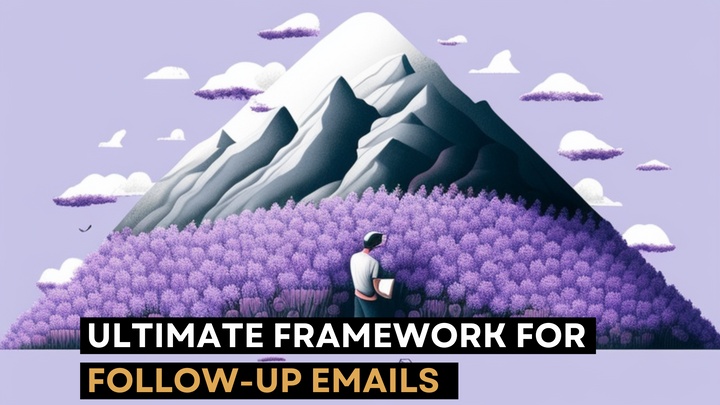Thread by Thread: Tactical Plays That Turn Partnerships into Sales Victories
Unlock the secrets of multi-threading in sales: partner-led strategies, psychology principles, and tactical plays to elevate your success.

The value of “multi-threading” is well-known in sales. The risk that a deal moves to close-lost decreases when you can make progress with multiple stakeholders within an account.
One thread might stall. A contact might leave the company. But, with multiple conversations going on, the risk of hitting a dead end reduces with every connection you make.
Similar to how discovery isn’t a stage in a deal cycle, multithreading isn’t unique to any deal stage.
It works for prospecting, deal management, closing, and even expansions.
Check out my thoughts on account-based prospecting here.
In the same thought process, partners can be a valuable resource for multi-threading.
A new trend has been evolving around partner-led sales strategies. You may have heard it called “Nearbound,” but if you’ve spent time in channel sales, this will all sound familiar.
Partners can help create a surround sound effect with buyers. They can open doors, move deals forward, and help you figure out how to navigate complicated orgs.
Leaning on partners is a newer tactic for sales reps who are used to going direct, so we wanted to clear the air on some of the psychology principles that will help you be successful. We'll present some plays you can use when trying to execute a partner-led strategy.
Regardless of the process stage, you must remember three major psychological principles behind every tactic described: social capital, reciprocity, and friction.
Social capital: When leaning on partners, you must recognize you are asking a partner to put their reputation on the line. This means there will be high barriers to wanting to help you. You must reduce their perceived risk so that they will expend “social capital” on your behalf.
Reciprocity: If you want to get something from a partner, one of the best ways is to give them something first or in exchange.
Friction: This one is easy. If you want someone to do something for you, make it easy for them. That means making the request easy to understand and doing as much of the heavy lifting for them as possible.
A partner is rarely compensated for giving you intel or putting in a good word. Reducing friction will also play into reciprocity.
With that in mind, here are three tactical plays (and some examples) you can use to start executing with partners.
The tactical plays I’ve seen most often are focused on getting:
- Intel on the account
- Someone to influence stakeholders
- An introduction
The ingredients of the frameworks:
- Context on:
- Who you want to talk to
- When you are or are looking to talk to them
- The partner’s relevance
- How you’re relevant to what they sold
- An ask (try to keep it simple)
- An offer (to stoke reciprocity)
The Intel Play
Say you’re about to go through the procurement process, and you’re looking to see what steps are involved so you can better forecast your deal. Or maybe you’re looking to see what a new department is focused on.
The intel play can help you get insight other sellers would kill for.
Here’s a framework and a few examples.
Examples:
1) From the Nearbound Blueprint
Lavender Score: 90
Subject: {account name}
Hey [Partner name X],
I’m talking to [Contact Y] next week over at [Account Z]. I noticed you closed them last quarter with buy-in from the [A department].
So that I’m presenting the most relevant case about our [joint value proposition of B], would you be willing to share any intel about the business initiative you aligned to?
A few of your top bullets would be extremely helpful. Respectfully,
[Rep Name]
P.S. Or if you’re open to hopping on a call for 15 minutes, maybe I could offer up some intel from my side on the [C account(s)] you’re selling to. I owned these opportunities and would be happy to trade notes.
2.
Lavender Score: 95
Subj: {fname of prospect} @ {account}
Will,
Saw you closed (Account) last quarter. I’m talking to (contact) about (priority) next week.
My guess is that (joint value prop) is going to resonate. Anything from your conversations that would be helpful to know?
Anything (even just a bullet point or two) would help.
PS. Saw you’re working (other account) and (other account). How’s it going? Happy to share notes.
3.
Lavender Score: 92
Subj: {your company name}: {fname of prospect} @ {account}
Will,
Do you think (joint value prop) will resonate with (name) at (account)?
Saw you sold into them last quarter. I meet with (name) next week.
PS. Happy to share notes on (account) or (account) if you need a hand there.
The Influence Play
The influence play requires more social capital from the partner than the intel play, and because of that, it can be impactful in driving progress in deals.
The goal is simple. Get the partner to put a good word in for you.
Examples:
1. From the Nearbound Blueprint
Hey [Partner Contact Name—AM],
I’m talking to [Opportunity Contact] over at [Opportunity Account] next week.
I noticed [they just renewed with you] last quarter. They mentioned in their last call how important [Company Name] was to [their strategy].
A part of the success plan I put together for them next week is our [Integration].
This is my first time talking with their [Contact Title], and I wanted to see if you’d be able to put in a good word with [Contact Name] about our partnership and the [Integration] over email or a call prior to then?
If so, I put together an email below that you can use that should highlight our joint value proposition.
Take a look and if you don’t mind sending it over, will you let me know?
In partnership,
[Seller Name]
[Email to be forwarded copy]
P.S. It looks like you share a couple of accounts with upsell opportunities that I recently sold as well like [Account Name 1 & 2]. Happy to discuss or help there if that’s valuable, just lmk.
2.
Lavender Score: 94
Will,
Saw {account} renewed with you last quarter. I’m talking to {name} next week.
Given how important {Will’s company} is to them, I plan on talking about our integration.
Think you’d be open to putting in a good word?
{joint account} and {joint account} are having a lot of success with it.
I’m happy to draft it up. Just let me know.
PS. Talking to (account) next week. Happy to return the favor. Looks like they’re on your list.
3.
Lavender Score: 92
Will - nice work getting (account) to renew last month.
I’m talking to (name) next week. Big ask, but would you mind putting in a good word?
Seems {Will’s company} is a strategic pillar. Want to lean on our strong integration.
I can draft up the whole note. Let me know.
PS. Happy to do the same when I talk to (account) next week. Do you know (name) yet?
The Intro Play
The intro play requires the most social capital of the plays described. They’re making an introduction on your behalf, so you should recognize there are social etiquette norms to abide by if you want this to work well consistently.
The first? You need the recipient to opt-in for the conversation. There is nothing worse than feeling forced into a conversation. Help your partner if they don’t know the rules by clarifying how you’d like them to manage the introduction. Don’t leave it to chance.
The other? Keep your partner up to date.
You want your partner to be available for an influence play or willing to make other introductions in the future. The easiest way to make that more likely is to keep them up to date with the progress of the introduction they made. Trust us, they’ll appreciate it more than you know.
Examples:
1. From the Blueprint
Subject: Intro to {account}
Hey [Contact Name],
I’ve been in comms with [Prospect Contact(s)] over at [Prospect Account] the past [few weeks].
I noticed [your relationship] with [Prospect Contact(s)], who I am trying to bridge the conversation over to.
I am positioning [value proposition] as the reason for that conversation with them.
Given your relationship, I'm reaching out with a draft email based on your feedback for an intro. I put a first draft with context on our previous comms below.
Take a look and if you don’t mind sending it over, will you let me know?
In partnership,
[Seller Name]
[Email to be forwarded copy]
P.S. It looks like we might share a handful of accounts/contacts I could Intro you to as well
I recently sold in [Relevant Industry Name]. Happy to discuss or help there if that’s valuable, just lmk.
Framework:
Context: Who you’re talking to
Context: Who they know you want to talk to
Why you want to talk to them
Ask: Context on what you’re providing & the ask itself
Forwardable copy
PS: Offer up some accounts
2.
Lavender Score: 92
Will,
Do you know {name} at {account} well enough to make an intro?
Realize it’s a big ask. Happy to help out with {account} and {account}. Looks like they’re open ops for you.
If you’re open to it, I’ll draft up a quick note for you to see if they’re open to it.
I’m talking to {other person} already. They seem excited about {value prop}, but it would be super helpful to get {name}’s buy-in.
3.
Lavender Score: 92
Will,
Saw you renewed {account} a couple of months ago.
I’m talking to {name} about {priority}. Realizing I need to get buy-in from {name}.
Do you know them well enough to make an intro?
Happy to draft it up a note you can send them. See if they’re open to it.
PS. Realize it’s a big ask. Looks like you’re working {account}. Talking to {Name} next week. Happy to do the same for you.




